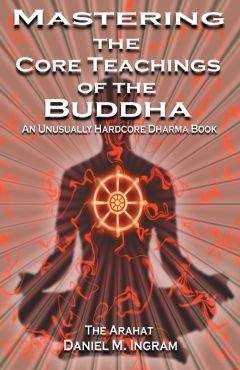Daniel Ingram - Mastering the Core Teachings of Buddha - An Unusually Hardcore Dharma Book
На электронном книжном портале my-library.info можно читать бесплатно книги онлайн без регистрации, в том числе Daniel Ingram - Mastering the Core Teachings of Buddha - An Unusually Hardcore Dharma Book. Жанр: Прочее издательство -, год 2004. В онлайн доступе вы получите полную версию книги с кратким содержанием для ознакомления, сможете читать аннотацию к книге (предисловие), увидеть рецензии тех, кто произведение уже прочитал и их экспертное мнение о прочитанном.
Кроме того, в библиотеке онлайн my-library.info вы найдете много новинок, которые заслуживают вашего внимания.

Daniel Ingram - Mastering the Core Teachings of Buddha - An Unusually Hardcore Dharma Book краткое содержание
Mastering the Core Teachings of Buddha - An Unusually Hardcore Dharma Book читать онлайн бесплатно
The Progress of Insight
reading my descriptions of these stages, pay attention to these separate aspects: the shift in perceptual threshold, the physical and mental raptures, the emotional and psychological tendencies, and the overall pattern of how that stage fits with the rest.
So, the meditator sits down (or lies down, stands, etc.) and begins to try to experience each and every sensation clearly as it is. When the meditator gains enough concentration to steady the mind on the object of meditation, something called “access concentration,” they may enter the first jhana, now called the “first vipassana jhana,” which is in some ways the same for both concentration practice and insight practice at the beginning. However, as they have been practicing insight meditation, they are not trying to solidify this state, but are trying to penetrate the three illusions by understanding the Three Characteristics.
They have been trying to sort out with mindfulness what is body and what is mind and when each is and isn’t there. They have been trying to be clear about the actual sensations that make up their world just as they are. They have been trying to directly understand the Three
Characteristics moment to moment in whatever sensations arise, be it in a restricted area of space, such as the area of the sensations of breathing, a moving area of space (e.g. body-scanning practices), in the whole of their world as is done in choiceless awareness practices, using some other technique or object, or just by being alive and paying attention.
Thus, this first stage has a different quality to it from that of concentration practice, and they attain to direct and clear perception of the first knowledge of...
1. MIND AND BODY
There is this sudden shift, and mental phenomena shift out away from the illusory sense of “the watcher” and are just out there in the world with the sensations of the other five sense doors. This is an important insight, as it shows us clearly and directly that we are not
“our” mind or “our” body. It is also a really nice, clear and unitive-feeling state (it really is still more state-like than stage-like), and people can try to hold on to it just as with the first jhana and get stuck. Reality can seem just a bit more brilliant the first time one chances into Mind and Body. We may feel more alive and connected to the world.
171
The Progress of Insight
With the sensate experience of both mental and physical
phenomena being clearly observable, the relationships and interactions between the two begin to become obvious. What is meant by “the dualistic split” is very obvious during this first stage.
Somewhere around the first stage, either just before it or shortly after it, there may arise odd jaw pains on one side, throat tensions, and some other such unpleasant physical occurrences. Regardless, it soon becomes easy to see that each sensation is followed by the crude mental impression of it, and that intentions precede actions and thoughts (see the discussion of impermanence in Part I, The Three Characteristics).
Thus, we come to...
2. CAUSE AND EFFECT
In this stage, the relationships between mental and physical phenomena become very clear and sometimes ratchet-like. The joy and wonder of Mind and Body have left, and now the interactions between the mind and body become somewhat mechanical seeming. Motions such as walking or the breath may begin to get jerky, as there is the intention and the motion, the sensation and the mental impression of it, the cause and the effect, all occurring in a way which can seem sort of tight and robot-like. You note, the breath moves just a bit. You stop noting, the breath stops. You note quickly, the breath jerks quickly. You note slowly, the breath follows. Some will stop noting quickly or stop noting at all, thinking that they are messing up the breath. The advice here is as before: note quickly, and don’t worry about what the breath does.
Remember how I recommended trying to experience one to ten
sensations per second consistently, noting which were mental and which were physical? At this stage, the meditator is finally able to do this with a fair degree of skill, confidence and consistency. Those with stronger concentration tendencies or a bent towards such things may notice thoughts and perhaps even visions of insight into cause and effect on a macroscopic scale, where past action or circumstances lead to various consequences, some event lead to some rebirth, some previous life lead to something today, and in general may get a sense that they are able to intuit aspects of the workings of karma in a way they did not before. As the meditator becomes more clear about the beginnings and endings of 172
The Progress of Insight
each of these, about the irritation caused by this jerkiness and about the fact that all of this seems to be happening fairly on its own, they come to directly perceive for themselves...
3. THE THREE CHARACTERISTICS
The Three Characteristics of impermanence, unsatisfactoriness and egolessness or no-self become predominant, which is good, as these are the fundamental basis for insight. Here it begins to become quite clear that these intentions and actions, sensations and the knowledge of them, and all of the constituents of this experience are quickly arising and passing, somewhat jarring, and not particularly in our control or us.
Further, as these sensations are all observed, including the crude mental impression that follows them (“consciousness”), the whole of the mind and body process is not a separate self. It is merely a part of the interdependent world.
These characteristics become clearer and clearer, as well as faster and faster, as the meditator diligently pays careful attention to exactly what is happening at each moment. For those doing noting practice, somewhere around here your speed and precision may begin to get so fast that you cannot note every sensation you experience. Move to more general noting, mono-syllabic noting (such as “beep” for each sensation experienced regardless of what it was), or drop the noting entirely and stay with noticing bare sensation come and go. At this stage, practice begins to really take off despite the fact that this stage tends to be fairly unpleasant.
This unpleasantness tends to be mostly physical, though this stage can also cause numerous dark feelings and a sense of wanting to renounce the world and practice. Occasionally, the early part of this stage can cause people to feel vulnerable, raw, and irritable to a small or large degree in the ways that a migraine headache or a bad case of PMS
can. I have occasionally been laid out on a couch for hours by this aspect of this stage, holding my head and just wishing that these early stages didn’t sometimes involve so much pain and anguish.
There may be odd bodily twistings, obsession with posture, and painful tensions or strange other sensations, particularly in the back, neck, jaw and shoulders. These tensions may persist when not meditating and be quite irritating and even debilitating. The rhomboid 173
The Progress of Insight
and trapezius muscles are the most common offenders. It is common to try to sit with good posture and then find one’s body twisting into some odd and painful position. You straighten out, and soon enough it does it again. That’s a very Three Characteristics sort of pattern. People sometimes describe these feelings as some powerful energy that is blocked and seems wants to get out or move through.
Feelings of heat and sensations like those of a fever may sometimes accompany this stage. One’s neck and back may become very stiff, either on one side or both sides. The right and left sides of one’s body may feel quite different from each other sometimes. The easiest way to get these unpleasant physical manifestations to go away is to keep investigating the Three Characteristics, either of them or of whatever primary object you have chosen. These are common early retreat experiences, particularly in the first few days.
Fighting them or trying other methods (backrubs, etc.) seems to either help only a little, work only temporarily, or sometimes make them even worse, though sometimes hatha yoga and related practices done with a high degree of awareness can be helpful. This is a common time for people to go to health practitioners of various kinds, from orthopedists and dentists to chiropractors and body workers. For example, I had a wisdom tooth removed during one pass through this stage because I thought it was throwing my jaw out of alignment, and perhaps it was, but this was clearly exacerbated by this stage of practice.
Even if these unpleasant physical manifestations do slack off for a bit, they are likely to keep coming back until one’s insight is sufficient to progress beyond this part of this stage. Thus, should one find such things interfering with one’s life, I recommend continued precise and accepting practice. This is a phase of practice when strong effort and very quick investigation really pay off.
Certain traditions may look at such physical manifestations as
“energy imbalances” or in some other negative light, and I can see where they are coming from, but I find those perspectives limiting.
Rather, I see this stage in its broader context as just one more phase of practice. Others may invent very strange stories to explain these experiences. A friend of mine ran into this ñana on retreat, found it very unpleasant, stopped practicing and began to spin out all sorts of fantastic 174
The Progress of Insight
stories in her head about how the poor fellow sitting next to her was very angry and how it was making her tense. This didn’t help whatsoever, and she got stuck there. I have learned to welcome these odd manifestations as clearly recognizable markers of progress on the path.
They are clear objects for practice and reassure me that I am on the right track. Unfortunately, this is a hard lesson to teach others. True, these manifestations can suck, but being able to appreciate what is happening in the face of the difficult stages is important, and becomes much more important later on.
As the mind gains speed at really seeing each of the sensations of the mind and body come and go, and the jerkiness from cause and effect can get quite rapid and pronounced. These physical movements and spasms seem to help break up the physical tension that may sometimes accompany this stage, and are a sign of progress.
4. THE ARISING AND PASSING AWAY
This is also the beginning of the second vipassana jhana. As in the second samatha jhana, the applied and sustained effort or attention begin to drop away, and meditation can seem to take on a life of its own.
In the early part of this stage, the meditator's mind speeds up more and more quickly, and reality begins to be perceived as particles or fine vibrations of mind and matter, each arising and vanishing utterly at tremendous speed. The traditional texts actually call this stage the beginning of insight practices, as from this point on there is a much more direct and non-conceptual understanding of the Three
Characteristics.
This stage is marked by dramatically increased perceptual abilities when compared with the previous stages. For example, one might be able to hone one’s awareness to laser-like precision on the tip of one’s little finger and seemingly be able to perceive the beginning and ending of every single sensation that made up that finger. Spontaneous physical movements and strange jerky breathing patterns that showed up in Cause and Effect and became more pronounced in the Three
Characteristics may speed up significantly. This stage explains where many practices such as Tibetan inner fire practices of the Yogic breath of fire come from. It can also reveal the source material that inspired 175
The Progress of Insight
teachings such as those about chakras and energy channels. Many descriptions of Kundalini awakening are talking about this stage.
Reality is perceived directly with great clarity, and great bliss, rapture, equanimity, mindfulness, concentration, and other positive qualities arise. Practice is extremely profound and sustainable, and there may be no pain even after hours of sitting. Unfortunately, the positive qualities that have arisen can easily become what are called the “Ten Corruptions of Insight” if the true nature of the individual sensations by which they are known are not understood as well, and until this happens a meditator can easily get stuck in the immature part of this stage.
The Ten Corruptions of Insight are: illumination, knowledge, rapturous happiness, tranquility, bliss, resolute confidence, exertion, assurance, equanimity and attachment. To quote the great meditation master Sayadaw U Pandita, from his great but very hard-to-find book, On the Path to Freedom, “As for the practicing yogi, he will at once recognize the above as imperfections of insight not representing dhamma breakthrough and are only to be noted off, remembering the teacher’s advice as to what is path and not path. Being disabled by the ten imperfections, he would not be capable of observing the triple characteristics in their true nature; but once freed from imperfections, he is able to do so.” In short, they may feel that they are now a very mighty meditator and that they should try to hold on to this forever, i.e.
they stop actually doing insight practices and instead solidify these qualities as concentration practice objects. Thus, the advice given about deconstructing and investigating the positive factors of the samatha jhanas, particularly the second one, is also very helpful when trying to stay on the narrow path of the progress of insight.
Visions, unusual sensory abilities (such as seeing nearby things through one’s closed eyelids), out of body experiences, and especially bright lights tend to arise to the meditator, sometimes first as jewel-tone sparkles and then as a bright white light (“I have seen the light!”). The technical meditator may easily sit for hours dissecting their reality into extremely fine and fast sensations and vibrations, perhaps even up to 40
per second or even more, with an extremely high level of precision and consistency. (Where the absurd and disheartening rumors of billions of mind moments per second come from is beyond me). Fine vibrations 176
The Progress of Insight
may spread over the body, revealing interference patterns between experiences, enabling one to know directly that when one thing is experienced, in that instant, something else is not.
It is very easy to confuse this stage with descriptions of stage 11.
Equanimity, especially as the stage before it, 10. Re-observation, has some distinct similarities to stage 3. The Three Characteristics. A brief discussion of the fractal nature of things that describes this will follow in the chapter called The Vipassana Jhanas. The big difference is that this stage is ruled by quick cycles, rapidly changing frequencies of vibrations, odd physical movements, strange breathing patterns, heady raptures, a decreased need for sleep, strong bliss, and a general sense of riding on a spiritual roller coaster with no breaks. The higher stages (10 and 11) do not have those qualities.
As to the cycles, they tend to proceed as follows, with this description assuming that you are using the breath as object. The mind kicks in, follows faster and faster vibrations, things really engage and speed up, perhaps accompanied by more pronounced shaking or
Похожие книги на "Mastering the Core Teachings of Buddha - An Unusually Hardcore Dharma Book", Daniel Ingram
Daniel Ingram читать все книги автора по порядку
Daniel Ingram - все книги автора в одном месте читать по порядку полные версии на сайте онлайн библиотеки My-Library.Info.




